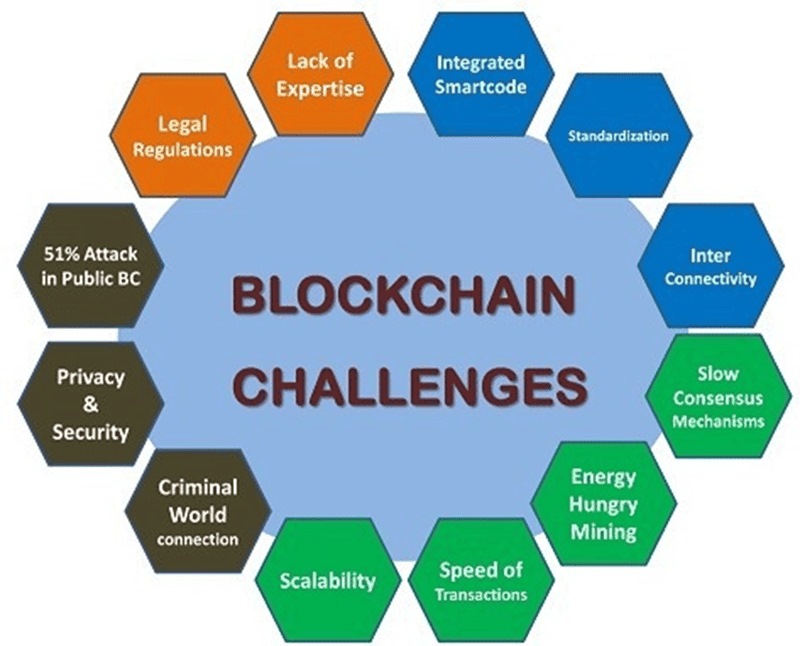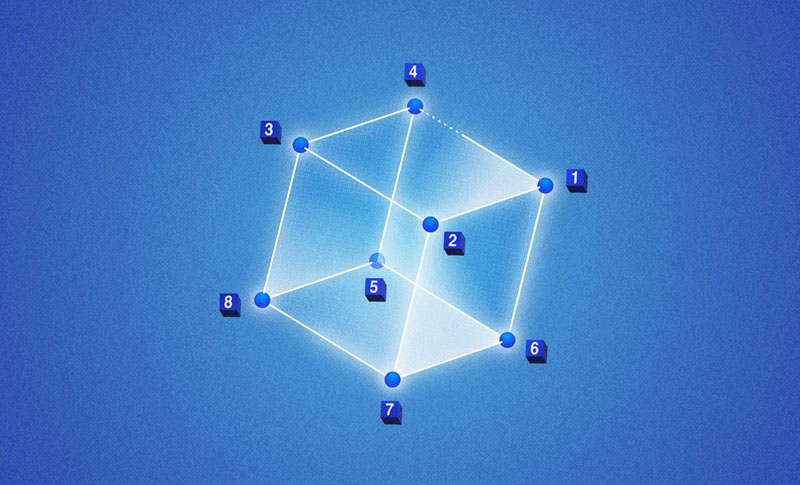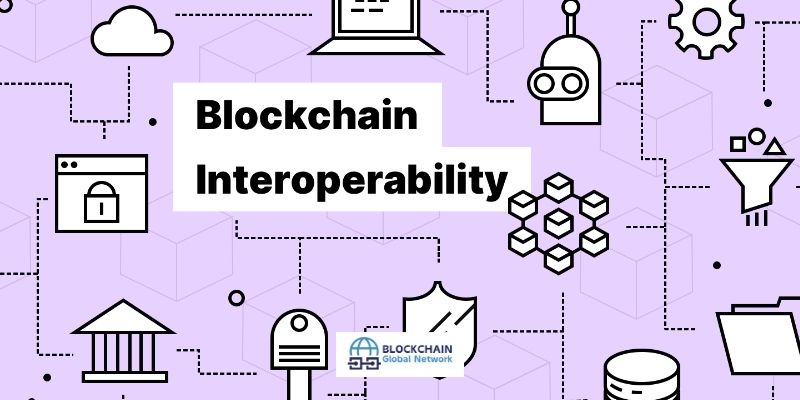Imagine a world where every digital step dances with trust—welcome to blockchain. Yet, as its adoption soars, so do the challenges. What are the challenges of blockchain? From scaling struggles to energy demands, and the tug-of-war between code and law, the journey ahead is anything but smooth. Ready to explore?
Understanding Blockchain Scalability and Performance Hurdles
Addressing Transaction Speed and Scalability
Think of blockchain like a road; cars are the transactions. Just like rush hour traffic jams, blockchains can get clogged. Why? Too many cars and not enough lanes. On crypto roads, this means slow rides and people late to their parties. While Bitcoin can take 10 minutes or more per transaction, newer tech aims for seconds.
How so? Some roads get more lanes, called ‘scaling solutions.’ These make room for more transactions at once. Others build high-speed side roads where select cars zip fast, then join back onto the main road later. Ethereum’s doing this with its ‘Layer 2’ plan.
Mitigating Network Congestion and Cost Implications
Now, what happens when our road gets packed? Costs shoot up. Fees to get your transaction in fast can pinch your wallet. Just like paying for a faster lane on the highway. When more folks want in, the price for speedy travel goes up.
But here’s a twist: those fees often fund network security. It’s like having a guard on every corner. Yet, high fees can turn folks away. No one wants to pay a fortune to send a bit of coin. These fees go up and down with traffic, so it’s a tricky balance.
To smooth things out, developers craft clever ways to keep things affordable. They find new methods to check transactions aren’t fake without breaking the bank. They also use ‘sharding,’ where the blockchain breaks into smaller bits, each handling some traffic.
In blockchain towns, we crave speed without a blow to our budgets. We’re in this race to find the smartest route. And with more brains joining, smarter paths reveal themselves each day, easing our ride on crypto roads.
The Environmental and Security Implications of Blockchain Technology
Crypto Mining’s Energy Consumption and Environmental Impact
We all love the idea of digital money. But mining it takes a lot of power. The process needs computers to solve complex puzzles. These computers are on all day, every day. This means high energy consumption crypto. The more we mine, the more energy we use. This can hurt our planet.
So, why does crypto use so much power? It’s because of something called proof of work. It keeps the network safe but needs lots of computing work. Some think of switching to proof of stake. This could cut down on the energy used.
There’s more to it, though. Renewable energy might help fix this. It’s cleaner and doesn’t run out. Places with lots of renewable energy could be key mining spots. This can cut down on the harm to our world.
Strengthening Security Measures Against Blockchain Vulnerabilities
Now let’s talk about keeping blockchain safe. Security is huge with digital money. We don’t want hackers stealing it. But sometimes, there are weak spots. These blockchain security concerns are real.
One issue is smart contract vulnerabilities. Smart contracts are like automatic rules on blockchain. If they have flaws, hackers can get in. We have to check these contracts well to keep them tight.
Another thing – our privacy. We want our information safe. So, blockchain privacy issues matter a lot. Encrypting data on the blockchain helps keep our details secret. Plus, it’s harder for bad folks to change data on blockchain. That’s because of something called immutability.
Yet, no system is perfect. There could be blockchain node vulnerabilities. Nodes are like the computers that hold up the network. If they go down, the whole thing can have problems.
But fear not, we’re always working on better safety measures. We’re finding new ways to fight off these risks every day. We make blockchain tough, so it’s a safe place for our digital coins.
By fixing these challenges, we keep making blockchain better. It can be safe and not as tough on our world. That way, we all win.
Navigating the Complex World of Blockchain Regulation and Privacy
Overcoming Regulatory Challenges and Cross-Border Compliance
Rules for cryptocurrencies vary a lot around the world. Some places welcome them. Others do not. New rules can pop up fast. This causes confusion. Businesses must work hard to follow these rules. Often, they must change how they operate. This can be tough and costly.
We must figure out how to deal with different rules in different places. For example, one country may let people use Bitcoin freely. But its neighbor might restrict it. If a blockchain works in both places, things get tricky.
Firms need to know who is using their services. This is called “know your customer” or KYC. It fights money laundering. It’s a big part of regulation today.
Rules aim to keep us safe from bad use of money, like funding crime. This is why they matter. There’s also the General Data Protection Regulation (GDPR) in Europe. It protects people’s data. It’s tough to follow when blockchains store data forever, visible to all.
Now, let’s talk about privacy. It’s a key promise of blockchain. But it’s getting harder to keep. Why? Because blockchains share data to work. People worry. They don’t want others to see their info. But they do want the perks of blockchains.
So, how can we balance privacy with sharing? It’s a big question. We need new ways to keep data safe. This will help keep people’s trust in using blockchains.
Ensuring Privacy While Maintaining Blockchain’s Transparent Nature
Privacy matters to everyone. Blockchains are super open. Each transaction is there for anyone to see. This openness is good for trust. But bad for privacy. How do we keep things private on a very open system? That’s our big challenge.
We could use fancy math, like zero-knowledge proofs. This lets you prove something without sharing secret details. You can say you’re old enough to buy a drink without showing your birth date.
There’s also mixing services. They help hide who is sending cryptocurrency to whom. They mix many transactions together. It’s like blending a smoothie. After mixing, it’s hard to tell who sent what to whom.
But here’s the trick. We want to stay open but not give away secrets. We must keep working on this balance. It means we need better tech and smart rules. It won’t be easy. But solving hard problems is what makes progress fun, right?
To wrap up, understanding regulation and privacy is like solving a giant puzzle. We need to fit all the pieces together. It takes patience, smarts, and teamwork. But the prize is worth it: a safe, fair, and private blockchain for all.
Advancing Blockchain Adoption and Interoperability
Tackling Obstacles to Mainstream Blockchain Utilization
Getting folks to use blockchain is tough. It’s new. It’s techy. It can seem really complex. Kids can grasp a game app in no time, right? But blockchain isn’t always that simple. There’s so much it can do, but how it does it… well, that’s not easy to explain to everyone. The tech behind it, like “consensus mechanisms,” can make people’s eyes glaze over. And we’re still figuring out the best way to make it all work fast and cheap, without causing big traffic jams in the network.
Also, security? Huge deal. If someone says “smart contracts,” most people don’t picture a deal being locked in safe and sound. They might think of hackers instead, because they’ve heard of attacks and money thefts. That’s why us folks working on it have to stay super sharp, rooting out any weaknesses before they cause trouble.
There’s worry about sneaky moves with money too. Bad actors using crypto for illegal stuff means we have to beef up anti-money laundering steps and know who’s who with KYC — that’s “know your customer.” It’s all about balance, making blockchain secure and clean without spooking people about their privacy.
Enhancing Interoperability Among Diverse Blockchain Platforms
Now let’s chat about buddies. No, not your pals, but blockchain platforms. They should get along like buddies, talking to each other smoothly. But right now, it’s like they speak different languages. Yeah, there’s a bunch of them. And they should ideally work together so businesses and people can use different ones without hassle.
You see, if blockchain is going to really stick around, it’s got to be simple to jump from one to another. That’s what “interoperability” is. Think of it like plugging your USB drive into any computer and it just works — that’s the dream. Trouble is, right now, it’s like needing a special adapter every time — what a pain! We’re working on it, though, making it so these blockchains can chat it up, no matter who built them or how they’re built.
When they finally work together well, whoa, the things we could do! Money could move around the world easy-peasy, and whole businesses could use blockchain in ways they can’t now. That’s what I’m excited about. We’re not just making new internet money here — we’re shaping new ways to move and keep track of anything of value. It’s like we’re building magical highways where cars drive themselves, you know?
Getting there… well, it’s not a cakewalk. It takes skilled people who get the tech, and yep, we need more of those. And all the tools, the rules — we’ve got to make them clear and use them right. It won’t be overnight, but mark my words: as more brains and hearts get behind this, we’ll make this blockchain thing a no-brainer for everyday use.
We’ve explored some tough parts of blockchain, like how to make transactions fast and cheap and how to prevent traffic jams on the network. We also looked at the impact of crypto mining on our planet and talked about how to keep blockchain safe from attacks. Understanding the rules and keeping things private while staying open and clear was another big topic. Finally, we covered making blockchain easier for everyone to use and talked about getting different blockchain systems to work together.
The bottom line is this: blockchain tech has big potential but faces challenges. It’s about finding balance – making sure it’s fast, cheap, green, safe, and clear for everyone. Finding solutions for these problems means a better blockchain for tomorrow. So let’s keep pushing forward, making blockchain better for all of us.
Follow Blockchain Global Network to stay updated on the latest trends, insights, and innovations in the world of blockchain
Q&A
- What are the most common obstacles facing blockchain technology?
The most prevalent challenges include scalability issues where the capacity to process transactions is limited compared to centralized systems, security concerns due to potential vulnerabilities, regulatory uncertainty as governments struggle to classify and legislate the tech, and interoperability problems with existing systems. Additionally, the widespread adoption of blockchain faces hurdles due to a lack of understanding and the significant energy consumption associated with some blockchain iterations.
- How does the scalability issue impact blockchain adoption?
Blockchain scalability issues pertain to the limited rate at which the network can process transactions, often leading to congestion and higher costs. As blockchain seeks broader adoption, the ability to handle a massive volume of transactions quickly and efficiently is crucial. Solving scalability is pivotal for blockchains to compete with established transaction processing services that currently offer greater speeds.
- What are the security concerns associated with blockchain technology?
Security concerns with blockchain often revolve around potential threats like 51% attacks, where an entity gains majority control of a blockchain’s hashing power, smart contract vulnerabilities, and code exploits. Despite the inherent security features of blockchain, such as decentralized ledger and cryptographic hashing, the technology is not impervious to all forms of cyberattacks.
- Can regulatory challenges hinder blockchain’s growth?
Regulatory challenges certainly pose a serious impediment to blockchain advancement. As a cutting-edge technology that transcends traditional financial and legal categories, blockchains can be difficult for policymakers to understand and, hence, regulate appropriately. This uncertainty can stymie investment, innovation, and wider implementation.
- What is meant by interoperability issues in blockchain?
Interoperability issues arise when different blockchain protocols cannot effectively communicate or exchange data with one another. This challenge is akin to the early days of email when various systems couldn’t interact. For blockchains to realize full potential, there needs to be a way to facilitate smoother interplay between different chains, allowing for greater cooperation and efficiency across various ecosystems.




RELATED POSTS
Comparison Of Consensus Mechanisms In Blockchain: Gatekeepers Unveiled
Discover the differences between PoW,...
Exploring Liquid Staking in Crypto: Unlocking 24/7 Earnings Potential
"Explore liquid staking in the...
LooksRare NFT: A new generation NFT exchange
LooksRare NFT has quickly emerged...
The Impact of Security: Unlocking Blockchain’s Mass Market Potential
The impact of security on...
Different Types of Crypto Wallets: Secure Your Digital Fortunes
Delve into different types of...
Hot Wallet vs Cold Wallet: Which Secures Your Crypto Best?
Hot wallet and cold wallet:...
What are the benefits of blockchain: How It Transforms Business and Daily Life
Discover the benefits of blockchain...
Blockchain Decoded: How Does Blockchain Work For Beginners
How does blockchain work for...
Blockchain Breakthrough: Blockchain In Supply Chain Management
Enhance supply chain management with...
Initial Coin Offering (ICO) Boom: Unpacking the Digital Gold Rush
Explore the ICO phenomenon: Basics...
Cost of Blockchain Security Audits: Are You Investing Wisely?
Understanding the Costs of Blockchain...
Government Regulation Post-Blockchain Hacks: Safeguarding Your Digital Future
Government regulation after blockchain hacks:...
Advantages and Disadvantages of Different Consensus Mechanisms: A Blockchain Breakdown
Explore the advantages and disadvantages...
NebulaStride Airdrop – Tips to Maximize Income
To maximize your income from...
Wewe Airdrop – Opportunities and Investment Potential in the Blockchain World
The Wewe airdrop is not...
Blockchain in Classrooms: Revolutionizing the Future of Education
Blockchain's Impact on Education: Enhancing...